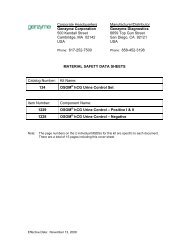Cholesterol (Liquid) Reagent Set - BrandSD
Cholesterol (Liquid) Reagent Set - BrandSD
Cholesterol (Liquid) Reagent Set - BrandSD
You also want an ePaper? Increase the reach of your titles
YUMPU automatically turns print PDFs into web optimized ePapers that Google loves.
<strong>Cholesterol</strong> (<strong>Liquid</strong>)<br />
<strong>Reagent</strong> <strong>Set</strong><br />
Example: Abs. (Patient) = 0.40, Abs. (Standard) = 0.32, Concentration of<br />
Standard = 200 mg/dl<br />
0.40 x 200 = 250 mg/dl<br />
0.32<br />
Quality Control<br />
Serum controls with known normal and elevated values should be run<br />
routinely to monitor the validity of the reaction. These controls should be run<br />
at least with every working shift in which <strong>Cholesterol</strong> assays are performed.<br />
It is recommended that each laboratory establish their own frequency of<br />
control determination.<br />
Expected Values 11<br />
Recommended Range:<br />
Desirable <strong>Cholesterol</strong>:<br />
Borderline-High <strong>Cholesterol</strong>:<br />
High <strong>Cholesterol</strong>:<br />
240mg/dl<br />
Manufactured by Pointe Scientific, Inc.<br />
5449 Research Drive, Canton, MI 48188<br />
European Authorized Representative:<br />
Obelis s.a.<br />
Boulevard Général Wahis 53<br />
1030 Brussels, BELGIUM<br />
Tel: (32)2.732.59.54 Fax: (32)2.732.60.03 email: mail@obelis.net<br />
Performance<br />
1. Linearity: 700 mg/dl<br />
2. Comparison: A comparison between this procedure and a similar dry<br />
powder reagent produced a regression equation of y = 1.02x + 0.8 with<br />
a correlation coefficient of 0.999.<br />
3. Precision:<br />
Within Run<br />
Run to Run<br />
Mean S.D. C.V.% Mean S.D. C.V.%<br />
157 1.1 0.7 155 1.3 0.8<br />
224 1.7 0.8 227 2.4 1.1<br />
4. Specificity: <strong>Cholesterol</strong> oxidase is not totally specific for cholesterol.<br />
Other analogs of cholesterol. Other analogs of cholesterol<br />
(dihydrocholesterol, 7-dehydrocholesterol, 20-hydroxycholesterol, etc.)<br />
are also oxidized. These analogs do not normally occur in any<br />
appreciable amounts in serum.<br />
References<br />
1. Lieberman, C., Ber. 18:1803 (1885).<br />
2. Burchard, H., Chem. Fentr. 61:25 (1890).<br />
3. Flegg, H.M., Ann. Clin. Biochem. 10:79 (1973).<br />
4. Richmond, W., Scand. J. Clin. Lab. Invest. 29:Suppl. 26, abstr. 3:25<br />
(1972).<br />
5. Allain, C.C., et al, Clin. Chem. 20:470 (1974).<br />
6. Roeschlau, P., et al, Z. Klin. Chem. Klin. Biochem 12:226 (1974).<br />
7. Trinder, P., Ann. Clin. Biochem. 6:24 (1969).<br />
8. Perlstein, M.T., et al, J. Microchem. 22:403 (1977).<br />
9. Witte, D.L., et al, Clin. Chem. 20:1282 (1974).<br />
10. Young, D.S. et al, Clin. Chem. 21:1D (1975).<br />
11. National Institute of Health Publication No. 88-2926 “Detection,<br />
Evaluation, and Treatment of High <strong>Cholesterol</strong> in Adults”, November<br />
(1987).<br />
Rev. 4/09 P803-C7510-01
















